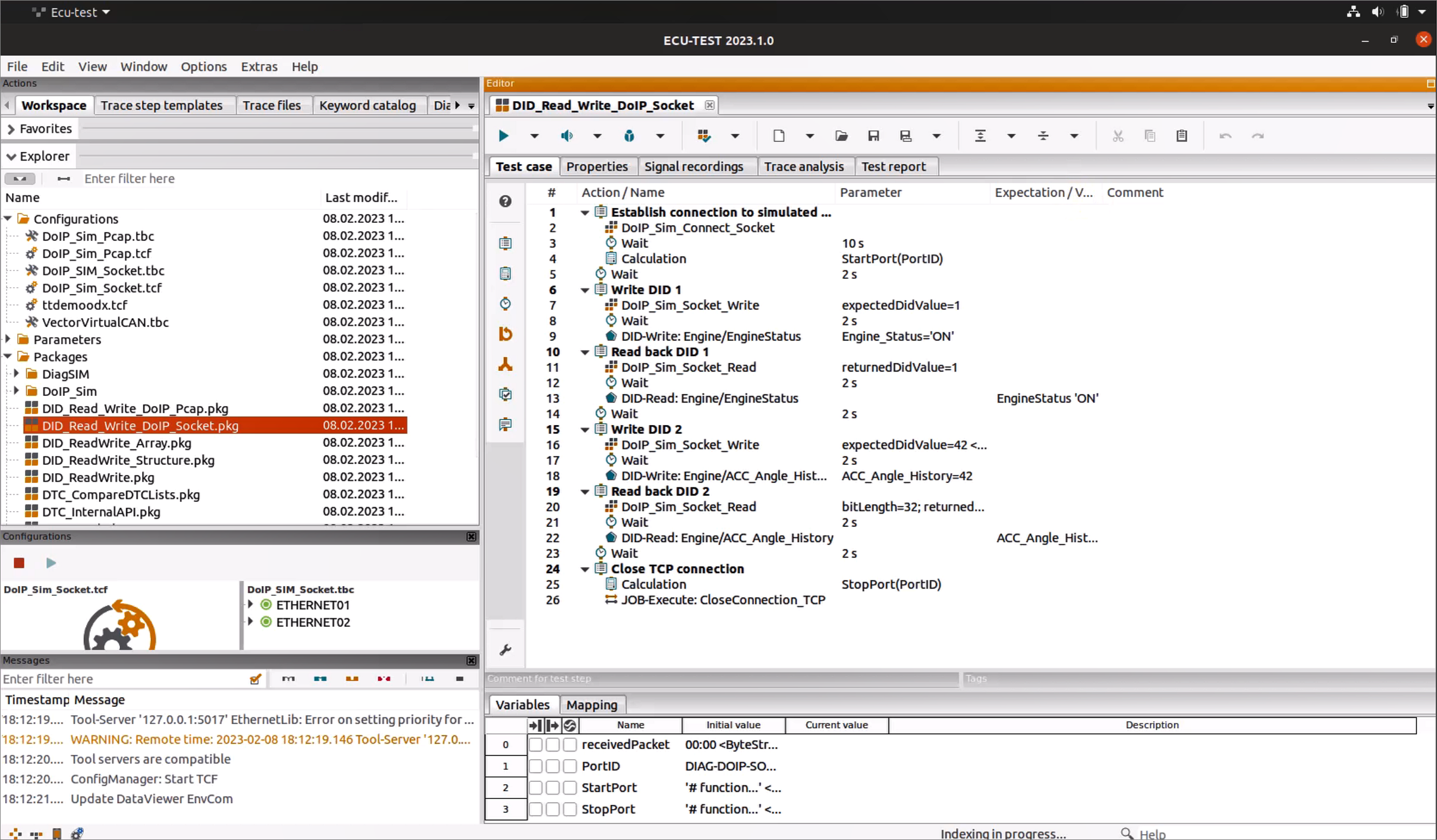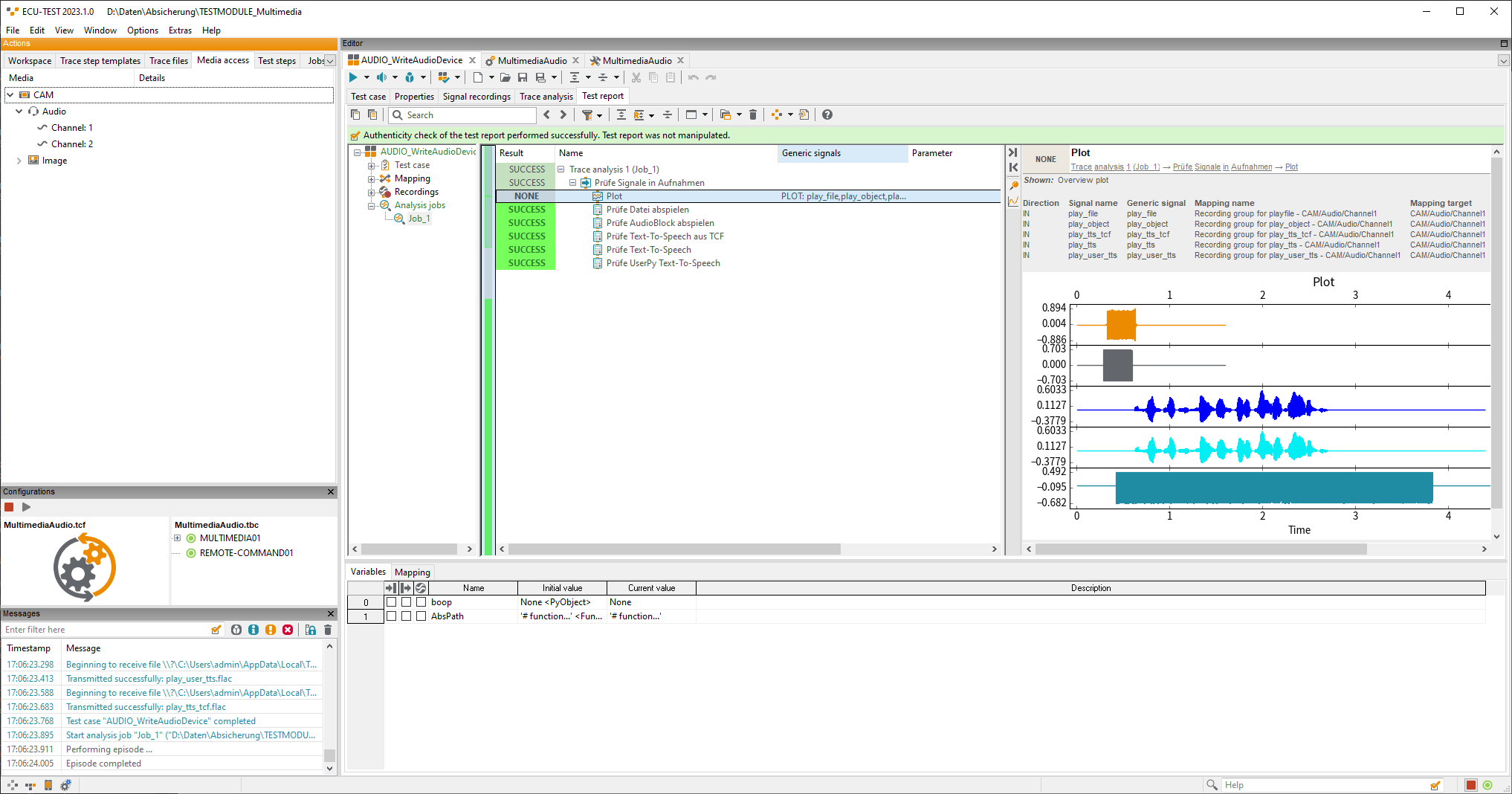In addition to the well-known Windows version, ECU-TEST is now also available under Linux with an alpha user interface. Ask us about it.
The tool connections provided cover the common tools running under Linux in the infotainment, powertrain and ADAS/AD domains. The ECU-TEST Linux version differs from the Windows version only by a few restrictions which cannot be implemented 1:1 under Linux, for example the support for Tortoise Git.
Currently ECU-TEST Linux can be installed and run under Ubuntu 20.04 LTS.
ECU-TEST Release 2023.1
Top features at a glance
Audio in test case and trace analysis
For several years ECU-TEST has been providing language tools and interfaces for testing infotainment systems. But so far, these have been limited to reading images and videos and comparing them to reference pictures. With ECU-TEST 2023.1, we now also provide analog tools for testing audio. The audio port on the multimedia tool can be used to connect various audio devices to ECU-TEST.
In the Multimedia tab of the Action window, an audio node containing the input channels is displayed. These channels can be read or recorded individually or together (audio nodes directly).
When reading, it is possible to define a recording duration and check if the recording contains a reference recording. The reference recording can be a Python object or an audio file in the workspace. The recording can also be stored as an AudioBlock in a variable and analyzed elsewhere.
When reading, it is possible to define a recording duration and check if the recording contains a reference recording. The reference recording can be a Python object or an audio file in the workspace. The recording can also be stored as an AudioBlock in a variable and analyzed elsewhere.
The audio node can also be written to. For this purpose, there is a new test step that plays audio files and AudioBlock objects. Alternatively, text can be read out using the Text-To-Speech option. The Windows speech output is available for this purpose. Other text-to-speech engines can also be connected as extensions and used in the same way.
Just like reading, individual channels or the entire source can also be dragged and dropped into the signal recording. Thus, the signals are available in the trace analysis.
Just like reading, individual channels or the entire source can also be dragged and dropped into the signal recording. Thus, the signals are available in the trace analysis.
Multimedia tool connection for ADB
Android is a popular platform for mobile devices, as well as a basis for infotainment. Android systems could already be accessed via Appium so far, but this access path had some limitations. For example, it was not possible to control parts of the screen sometimes. With the ADB connection, these limitations no longer exist. Images of the screen can be taken and actions can be triggered on the device via a job.
Note: ScreenCopy is an optional part of the connection. With this program, a second manipulable preview window can be displayed.
Test step controlled sending of events for SOME/IP based service communication
In order to use the SOME/IP simulation functions in ECU-TEST, it was previously possible to generate Python scripts and customize one's own environment.
With the newly created mechanism for sending events, a service simulation can now be activated quickly and easily. One also benefits from the ECU-TEST mapping options to modify paths when changing the (ARXML) system descriptions. The function can be used along with the SERVICE(-PCAP) port on the Ethernet/XL-API tool.
With the newly created mechanism for sending events, a service simulation can now be activated quickly and easily. One also benefits from the ECU-TEST mapping options to modify paths when changing the (ARXML) system descriptions. The function can be used along with the SERVICE(-PCAP) port on the Ethernet/XL-API tool.
Support for sending with PDU-based Ethernet communication
All functions provided for sending PDUs for classic CAN/FlexRay bus communication can now also be used via the SOCKET-ADAPTOR-ACTIVE port on the following tools:
This includes sending via port jobs, mini-RBS and the signal-group-write-test steps for single and cyclic sending. Transmission is currently supported for the UDP transport protocol, for nPDUs with header and for a transmission via multicast.
- TraceTronic: Ethernet
- Vector: XL-API
This includes sending via port jobs, mini-RBS and the signal-group-write-test steps for single and cyclic sending. Transmission is currently supported for the UDP transport protocol, for nPDUs with header and for a transmission via multicast.
New APIs ...
... for querying debugger symbols
With the new Debug DataBrowser API it is possible to query information from ELF descriptions in order to generate test cases along with other APIs (e. g. package or parameter set API).
... for querying ARXML service descriptions
With the new Service Browser API it is possible to query information from ARXML service descriptions. For example, test cases can be generated based on this catalog along with other APIs (e.g. package or parameter set API).
The extensive list of available functions is given in the user help under " ../DataBrowser/ServiceBrowser".
With the new Debug DataBrowser API it is possible to query information from ELF descriptions in order to generate test cases along with other APIs (e. g. package or parameter set API).
... for querying ARXML service descriptions
With the new Service Browser API it is possible to query information from ARXML service descriptions. For example, test cases can be generated based on this catalog along with other APIs (e.g. package or parameter set API).
The extensive list of available functions is given in the user help under " ../DataBrowser/ServiceBrowser".






